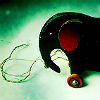Session Overview

|
How good is your memory? What different types of memory do we have? What kind of factors can affect how we retain certain information in our memory? During this session, we will explore steps by which we create and store memories and the different categories of memories. Keywords: memory, flashbulb memories, short and long term memory, proactive and retroactive interference, Ebbinghaus’s curve of forgetting, mnemonist Image by Andrew B47 on Flickr. |
Session Activities
Readings
Read the following before watching the lecture video.
- [Sacks] Chapter 2 “The Lost Mariner” (pp. 23-42)
- Begin one of these chapters in your chosen textbook:
Lecture Videos
View Full Video
View by Chapter
- Short Term Memory
- Long Term or Secondary Memory
- Proactive and Retroactive Interference
- A Mnemonist’s Memory
- Flashbulb and Repressed Memories
Video Resources
- Clips removed from lecture video due to copyright restrictions:
- Excerpt from Divided Memories. PBS Frontline. Airdate April 4, 1995.
- Lecture Slides (PDF)
Further Study
These optional resources are provided for students that wish to explore this topic more fully.
| TYPE | CONTENT | CONTEXT |
|---|---|---|
| Podcast | Audio podcast: “Limits of the Mind.” From “Limits,” Radiolab season 7, episode 3 (2010). | 19 minute segment on the limits of human memory, including more on the case of mnemonist “S” studied by A. R. Luria (as discussed in this lecture). |
| Article | Trafton, A. “3 Questions: John Gabrieli on studying traumatic memories.” MIT News Office, Sept. 9, 2011. | Prof. Gabrieli discusses a large-scale study on how people remember the 9/11 attacks, and what that tells us about memories of emotionally significant events. |
| Assignment | See the Further Study section of the Child Development session for a writing assignment on whether “recovered” memories are real or false. | Research by Loftus et al, whose work is discussed in this lecture’s segment on eyewitness memories, is part of the assignment. |










